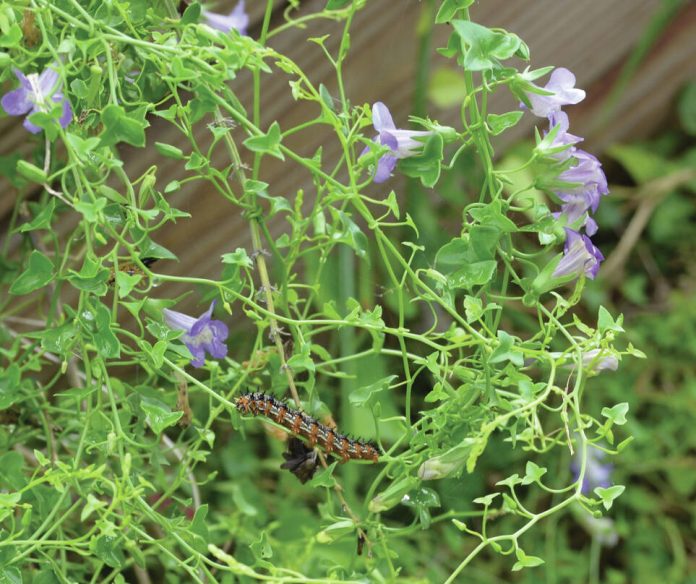By whatever name, nectar, pollinator and butterfly gardens result in mostly the same: attracting colorful butterflies, bees and beneficial garden insects.
Butterflies, moths, and other insects get energy from sugar-rich nectar. Nectar attracts pollinators like bees, flies, wasps and beetles that drink nectar and in addition, transfer pollen, a protein, from flower to flower. Hummingbirds draw nectar from tubular shaped flowers and are pollinators, too. In some geographical areas, bats pollinate flowers and fruit plants. Grasses, cereal crops, various trees, vegetables and yucca are wind pollinated.
A butterfly garden also includes specific plants that feed caterpillars, called larval host plants. For instance, cow pen daisy, Verbesina encelioides; frostweed, Verbibesina microptera, and sunflowers are host plants for bordered patch butterflies; passion flowers, Passiflora species, are hosts for fritillary and heliconian caterpillars; Adelia vasseyi is host to Mexican bluewing. The big yellow sulphur butterflies use a variety of plants in the legume family, including sennas; white peacock butterflies use frog fruit, Phyla nodiflora; Ruellia nudiflora; and herb-of-grace, Bacopa monnieri, plants. Dalea scandens hosts Southern dogface caterpillars; and Texas torchwood, Amyris texana; Colima, Zanthoxylum fagara, and other citrus family plants feed giant swallowtail caterpillars.
An easy start to a beneficial garden follows a concept promoted by Doug Tallamy, University of Delaware professor and author of several popular books, including “Nature’s Best Hope — Restoring Nature’s Relationships.” He proposes “combined yards across the nation into the largest nature park” in the United States. Every yard would incorporate a four-foot square area for geographically native plants of staggered heights, bloom times and color variety. A model that can benefit yards in the Rio Grande Valley, using locally native plants.
Another type of garden has specific guidelines for certification: the Monarch Waystation. A concept of the nonprofit organization, Monarch Watch, it must include larval plants for monarch butterflies. Monarch caterpillars feed exclusively on milkweed plants. Different geographical areas support different milkweed species. The best for the Rio Grande Valley is zizotes milkweed, Asclepias oenotheroides. For Monarch Waystation criteria visit https://www.monarchwatch.org/waystations/.
I love butterflies, so I try to have nectar plants blooming during each season. Some plants, like winter-blooming pink mint, Stachys drummondii, are busy with numerous butterflies through January and February. The plants are prolific re-seeders and maintenance free. They attract butterflies and interesting pollinator varieties of bees, wasps, flies, moths and other bugs.
Some plants may bloom in all seasons, like snapdragon vine, Maurandella antirrhiniflora, a delicate looking but hardy vine; tropical sage, Salvia coccinea; yellow sophora shrub, Sophora tomentosa; and Turk’s cap, Malvaviscus drummondii, that can grow in shade; and all of which attract hummingbirds, too. Scorpion’s tail, Heliotropium angiospermum, is another excellent butterfly favorite that may bloom nearly all year.
Dense shrubby plants, like Mexican hat, Ratibida columnifera, provide nighttime sheltering for insects as does crucita, Chromolaena odorata. Also called fall blooming mistflower, crucita is a bushy shrublike plant and one of the best nectar plants in all of South Texas. Both crucita and frostweed are fall bloomers and draw many species of butterflies, insects and pollinators.
Anita Westervelt is a Texas Master Naturalist.




